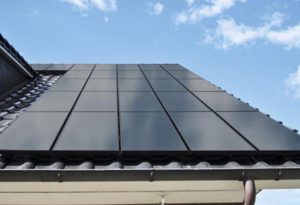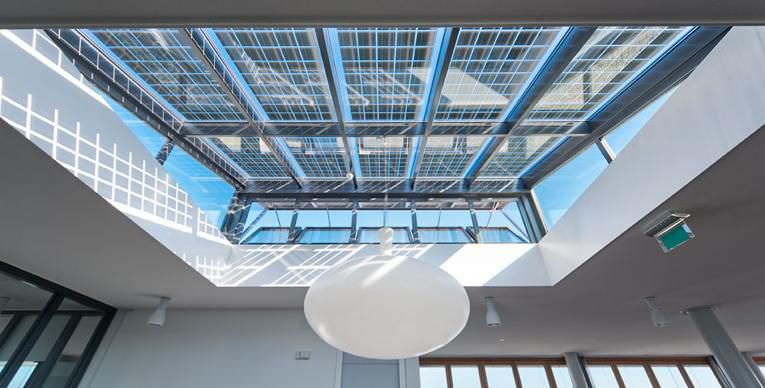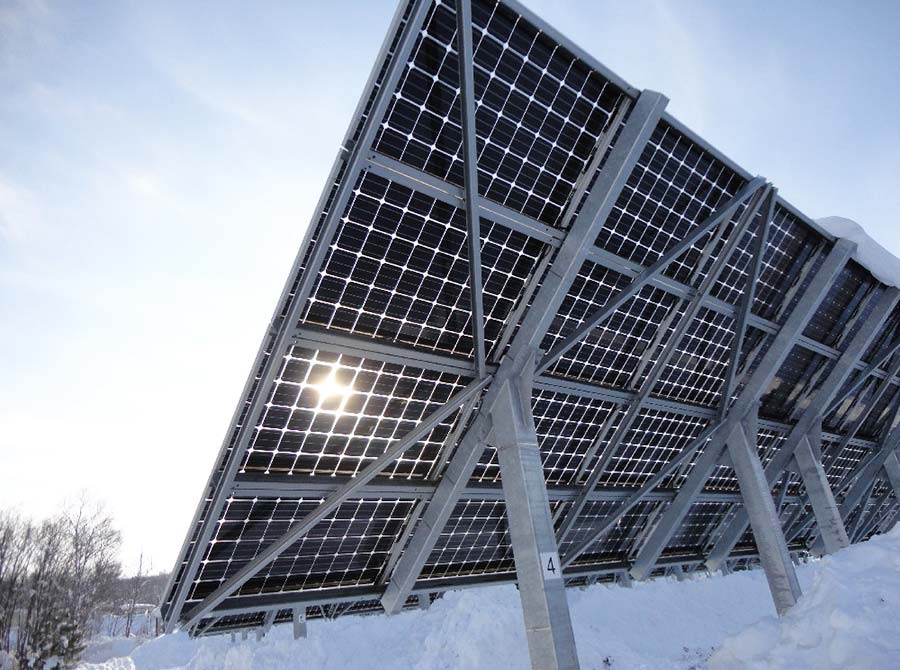In today’s fast expanding solar industry, there are already hundreds of different panel models and designs available to the modern day solar shopper. A growing number of premium technology brands (think Panasonic and LG) have entered the residential solar market, leaving homeowners across the country wondering: what’s next? What new technologies can we expect for solar panels in 2019? In this article we will discuss all of the new developments with photovoltaic (PV) panels, including new aesthetics like clear solar panels, bi-facial (double-sided) panels, efficiency improvements and solar inverter integration. lve that problem, major manufacturers such as SolarWorld, Canadian Solar, and Trina are
producing frameless solar modules. The main hinderance for these aesthetic panels is the lack of suitable mounting equipment that can work without a frame. As a result, manufacturers are producing specialized mounting apparatus to match their frameless panels. One example of this is Lumos Solar, which offers the LSX Frameless Module as well as its own dynamic mounting solution.
lve that problem, major manufacturers such as SolarWorld, Canadian Solar, and Trina are
producing frameless solar modules. The main hinderance for these aesthetic panels is the lack of suitable mounting equipment that can work without a frame. As a result, manufacturers are producing specialized mounting apparatus to match their frameless panels. One example of this is Lumos Solar, which offers the LSX Frameless Module as well as its own dynamic mounting solution. Genuine solar windows are a new residential concept we will be watching for in 2019. This solar window product, sometimes referred to as “clear solar panels,” would be a legitimate example of BIPV. To date, this type of window replacement glass solar has only been used for utility scale solar installations, primarily in Europe.
Genuine solar windows are a new residential concept we will be watching for in 2019. This solar window product, sometimes referred to as “clear solar panels,” would be a legitimate example of BIPV. To date, this type of window replacement glass solar has only been used for utility scale solar installations, primarily in Europe.

 an either draw attention to or minimize the look of solar modules on your roof. For example, the startup’s PV skins allow the panels to directly match the color and aesthetic of its roof shingles without interfering with panel efficiency or output. Sistine Solar’s skin product is expected to hit U.S. markets in 2018.
an either draw attention to or minimize the look of solar modules on your roof. For example, the startup’s PV skins allow the panels to directly match the color and aesthetic of its roof shingles without interfering with panel efficiency or output. Sistine Solar’s skin product is expected to hit U.S. markets in 2018.  LG introduced its bifacial “Cello” technology in 2016 with the launch of the Neon2 panel, which boasts increased power output as well as an improved aesthetic thanks to its frameless apparatus and sleek black appearance. In tandem, manufacturer behemoth SolarWorld unveiled its Sunmodule XL bi-facial at Solar Power International in 2016. The high-wattage 72-cell module offers a 25 percent increase in power output due to its double-sided silicon technology. Another impressive feat by this new product is its improved solar capacity: a 330 watt SolarWorld panel will offer comparable output to that of a standard 410 watt panel. It is forecasted that the PV industry will see solar panels with capacities as high as 435 watts in 2019.
LG introduced its bifacial “Cello” technology in 2016 with the launch of the Neon2 panel, which boasts increased power output as well as an improved aesthetic thanks to its frameless apparatus and sleek black appearance. In tandem, manufacturer behemoth SolarWorld unveiled its Sunmodule XL bi-facial at Solar Power International in 2016. The high-wattage 72-cell module offers a 25 percent increase in power output due to its double-sided silicon technology. Another impressive feat by this new product is its improved solar capacity: a 330 watt SolarWorld panel will offer comparable output to that of a standard 410 watt panel. It is forecasted that the PV industry will see solar panels with capacities as high as 435 watts in 2019.

The cost of solar is dropping across the nation. See prices in your area and get free solar quotes on the EnergySage Marketplace.
What are the new solar panel designs and aesthetics?
One of the most common criticisms of the solar panels available today is their appearance on a roof – many homeowners considering solar are looking for a product that will both generate energy and offer a stylish and aesthetic improvement for their property. In response, solar panel manufacturers are developing new solutions to give solar the makeover homeowners have been asking for.Frameless solar panels
A major factor in the critique of solar’s aesthetic is the solar panel frame, which many homeowners find to be the least attractive part of a PV panel. To so lve that problem, major manufacturers such as SolarWorld, Canadian Solar, and Trina are
producing frameless solar modules. The main hinderance for these aesthetic panels is the lack of suitable mounting equipment that can work without a frame. As a result, manufacturers are producing specialized mounting apparatus to match their frameless panels. One example of this is Lumos Solar, which offers the LSX Frameless Module as well as its own dynamic mounting solution.
lve that problem, major manufacturers such as SolarWorld, Canadian Solar, and Trina are
producing frameless solar modules. The main hinderance for these aesthetic panels is the lack of suitable mounting equipment that can work without a frame. As a result, manufacturers are producing specialized mounting apparatus to match their frameless panels. One example of this is Lumos Solar, which offers the LSX Frameless Module as well as its own dynamic mounting solution.Clear solar panels
Many frameless panel designs are entirely enclosed in one material, typically glass. Glass solar panels use the same silicon cell technology and materials of a standard panel, but rather than being mounted on an opaque backing material, the cells are sandwiched between two glass casings. In most scenarios, glass panels are bi-facial, but we will save that concept for later in the article.Glass solar panels are an innovation in multiple ways because, in addition to being more visually attractive, glass panels are more durable than a typical silicon cell panel. These panels are known to be significantly more resistant to fire hazard and are also less prone to erosion. Prism Solar, DSM Advanced Surfaces, Topray Solar and Sunshine Solar are some of the leading solar glass manufacturers in the industry today. Though glass-on-glass panels are often integrated into a skylight or building window (as in the image below), they are not truly “building integrated photovoltaics” because they are attached to the building rather than incorporated into the building envelope. Genuine solar windows are a new residential concept we will be watching for in 2019. This solar window product, sometimes referred to as “clear solar panels,” would be a legitimate example of BIPV. To date, this type of window replacement glass solar has only been used for utility scale solar installations, primarily in Europe.
Genuine solar windows are a new residential concept we will be watching for in 2019. This solar window product, sometimes referred to as “clear solar panels,” would be a legitimate example of BIPV. To date, this type of window replacement glass solar has only been used for utility scale solar installations, primarily in Europe.
Tesla solar tiles
Tesla’s new roof panels are a unique, distinct product and should be placed in their own category of panel innovation. The four PV shingle designs, announced at the end of October, offer a design promise entirely unique from any other product coming to the solar market: they are unequivocally non-recognizable. The latest from Elon Musk allows homeowners to go solar without any noticeable difference on their roof. As demonstrated at Tesla’s launch event, these solar tiles are significantly more durable than the standard roof materials commonly used today. The solar roof product is designed to blend in with typical roof aesthetics and thus will come in the following product lines: Tuscan glass, slate glass, textured glass and smooth glass tiles.
Solar skin design
Sistine Solar, a Boston-based design firm, is making big strides with the concept of rooftop solar panels with a customized look. The MIT startup has created a “solar skin” product that allows solar panels to have a distinguished look that c an either draw attention to or minimize the look of solar modules on your roof. For example, the startup’s PV skins allow the panels to directly match the color and aesthetic of its roof shingles without interfering with panel efficiency or output. Sistine Solar’s skin product is expected to hit U.S. markets in 2018.
an either draw attention to or minimize the look of solar modules on your roof. For example, the startup’s PV skins allow the panels to directly match the color and aesthetic of its roof shingles without interfering with panel efficiency or output. Sistine Solar’s skin product is expected to hit U.S. markets in 2018. New solar panel product improvements
With well over 200,000 workers in the U.S. PV industry, it’s no surprise that new panel efficiencies and product improvements are announced practically every week. In some cases, it’s difficult to stay up to date on all of the developments in solar panel technology. In the past two years, the concept of “average solar efficiency” has risen from the 14-15 percent range up to 16-17 percent – a significant margin. In 2019, there are 60-cell solar panels that have comparable outputs to 72-cell panels. Efficiency is changing the affordability of solar and the residential market is set to reap the benefits.One company to note is Panasonic, which is challenging the likes of SunPower with premium PV efficiencies (upwards of 20%) offered at mid-tier prices. A big reason for the success of this manufacturer and tech giant is their dynamic heterojunction panel product (HIT) that combines maximum efficiency and optimized temperature control to allow for top performance under extreme conditions of sunlight. And now for its next trick: Panasonic recently announced that it will manufacture the solar cells for Elon Musk’s illustrious solar roof. With aesthetic design, high efficiency and BIPV rising up as the next big trends in solar manufacturing, Panasonic is a company to keep an eye on. Other PV innovators have been LG and SolarWorld, which are both making major strides in the world of bi-facial panels, glass-on-glass, inverter integration and high capacity PV.Double-sided solar panels
Formally known as bi-facial solar panels, double-sided PV is a hot topic in solar and will continue to be an attractive product option for homeowners in 2019. Double-sided panels offer the value described in their name: they can harness sunlight through both surfaces of the panel. The simple premise is that double-sided panels can capture light as it reflects off of the roof or ground surface below the panel. Because the majority of roofs in the residential market are black, installers will typically paint a white border around the solar panel system before installation to maximize light reflection. In the case of ground mount solar, the light will naturally reflect off the ground (especially during winter, when the modules will benefit from a naturally white ground surface due to snowfall). LG introduced its bifacial “Cello” technology in 2016 with the launch of the Neon2 panel, which boasts increased power output as well as an improved aesthetic thanks to its frameless apparatus and sleek black appearance. In tandem, manufacturer behemoth SolarWorld unveiled its Sunmodule XL bi-facial at Solar Power International in 2016. The high-wattage 72-cell module offers a 25 percent increase in power output due to its double-sided silicon technology. Another impressive feat by this new product is its improved solar capacity: a 330 watt SolarWorld panel will offer comparable output to that of a standard 410 watt panel. It is forecasted that the PV industry will see solar panels with capacities as high as 435 watts in 2019.
LG introduced its bifacial “Cello” technology in 2016 with the launch of the Neon2 panel, which boasts increased power output as well as an improved aesthetic thanks to its frameless apparatus and sleek black appearance. In tandem, manufacturer behemoth SolarWorld unveiled its Sunmodule XL bi-facial at Solar Power International in 2016. The high-wattage 72-cell module offers a 25 percent increase in power output due to its double-sided silicon technology. Another impressive feat by this new product is its improved solar capacity: a 330 watt SolarWorld panel will offer comparable output to that of a standard 410 watt panel. It is forecasted that the PV industry will see solar panels with capacities as high as 435 watts in 2019.PV integration: solar panel with inverter
A big factor in the world of PV is the concept of solar efficiency, which refers to the rate at which silicon cells can convert rays of sunlight into electricity. And while panel efficiency gradually increases every year, the efficiency of solar panel manufacturing and installation is also improving. Curious how solar panel efficiency and cost has changed over time? Read our articleA new innovation seen across the industry is the concept of a solar panel plus inverter. For solar installers, inverter installation and connection can add significant time to a typical rooftop installation. To solve this problem, innovative manufacturer Enphase is making inverters easily attachable to the back of the panel. The U.S. inverter specialist has announced partnerships with a number of leading panel manufacturers in the past few months in an effort to create a module that does not require the installation of an inverter. Instead, the modules will be manufactured with small inverters already in place on the back of the panel. For the solar market as a whole, this seemingly minor technical innovation will contribute to significant reductions in installation time, which results in reduced installation costs. To date, Enphase’s major partnerships in the panel-inverter integration effort have been with SolarWorld, LG and Jinko Solar.Three Tips for Solar Shoppers
1. Homeowners who get multiple quotes save 10% or more
As with any big ticket purchase, shopping for a solar panel installation takes a lot of research and consideration, including a thorough review of the companies in your area. A recent report by the U.S. Department of Energy’s National Renewable Energy Laboratory (NREL) recommended that consumers compare as many solar options as possible to avoid paying inflated prices offered by the large installers in the solar industry.To find the smaller contractors that typically offer lower prices, you’ll need to use an installer network like EnergySage. You can receive free quotes from vetted installers local to you when you register your property on our Solar Marketplace – homeowners who get 3 or more quotes can expect to save $5,000 to $10,000 on their solar panel installation.2. The biggest installers typically don’t offer the best price
The bigger isn’t always better mantra is one of the main reasons we strongly encourage homeowners to consider all of their solar options, not just the brands large enough to pay for the most advertising. A recent report by the U.S. government found that large installers are $2,000 to $5,000 more expensive than small solar companies. If you have offers from some of the big installers in solar, make sure you compare those bids with quotes from local installers to ensure you don’t overpay for solar.3. Comparing all your equipment options is just as important
National-scale installers don’t just offer higher prices – they also tend to have fewer solar equipment options, which can have a significant impact on your system’s electricity production. By collecting a diverse array of solar bids, you can compare costs and savings based on the different equipment packages available to you.There are multiple variables to consider when seeking out the best solar panels on the market. While certain panels will have higher efficiency ratings than others, investing in top-of-the-line solar equipment doesn’t always result in higher savings. The only way to find the “sweet spot” for your property is to evaluate quotes with varying equipment and financing offers.For any homeowner in the early stage of shopping for solar that would just like a ballpark estimate for an installation, try our Solar Calculator that offers upfront cost and long-term savings estimates based on your location and roof type. For those looking to get quotes from local contractors today, check out our quote comparison platform.






